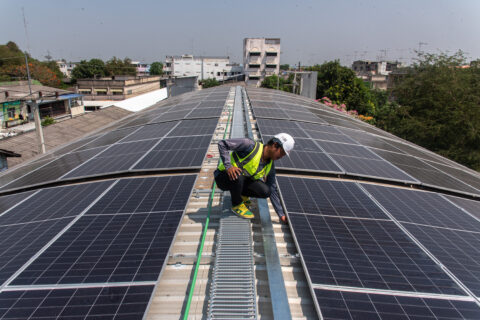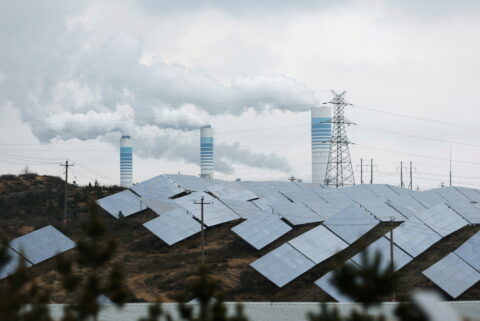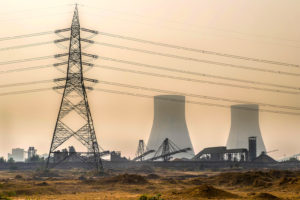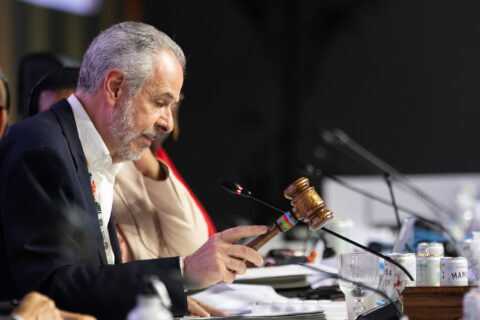In a surprise move, US president Joe Biden has announced a “temporary pause” on liquified natural gas (LNG) terminal expansion.
It has been described by some as an “election year decision” to please climate activists and by others as a distraction that might even raise global emissions.
In recent years LNG exports from the US have boomed, causing the country to leapfrog Australia and Qatar to become the world’s largest LNG exporter in 2023.
These exports have helped Europe make up the shortfall left behind by a drop in fossil-fuel supplies from Russia, following its invasion of Ukraine.
However, current and proposed EU climate policies imply a significant drop in demand for fossil fuels, including LNG imports. As such, a group of EU lawmakers have urged Biden not to use Europe as an “excuse” for further expansion.
Citing his reasons for the temporary pause in new terminal expansion, Biden said there is now “an evolving understanding of the market need for LNG, the long-term supply of LNG and the perilous impacts of methane on our planet”.
Indeed, there is already more than enough LNG export capacity to meet global demand for the fuel, if countries meet national and international climate goals.
But the move has drawn criticism from some commentators and fossil-fuel industry representatives, who have argued that it could lead to countries sourcing LNG from other countries with more polluting practices – or even encourage them to use more coal.
Below, Carbon Brief sets out the reasons why Biden has paused approvals of new LNG terminals, how much LNG capacity is currently in the global pipeline and whether the world really needs more US LNG exports.
It also explores how Biden’s move could affect global emissions, noting that criticisms put forward by oil industry representatives contradict evidence showing that all fossil fuels must rapidly be phased out to meet the world’s climate goals.
- Why has the Biden administration ‘paused’ new LNG expansion?
- How much new LNG capacity is currently in the US, and global, pipeline?
- Does the world need US LNG following Russia’s invasion of Ukraine?
- How will the supply of US LNG affect global greenhouse gas emissions?
- How will the move affect US politics in the coming months?
Why has the Biden administration ‘paused’ new LNG expansion?
On 9 January, Politico reported that Biden’s aides were considering conducting a review that “could tap the brakes on the booming US natural gas export industry”.
It said that the review was being led by the Department of Energy and would “examine whether regulators should take climate change into account when deciding whether a proposed gas export project meets the national interest”.
Examining Biden’s possible motivations for such a review, Politico said:
“US gas exports have jumped four-fold during the past decade as production has surged, turning the US into the world’s largest natural gas exporter and helping Europe replace Russian shipments after Moscow’s invasion of Ukraine. But Biden also faces growing pressure from environmental groups to live up to his pledge to transition away from fossil fuels – something the US also promised to do at last month’s climate summit in Dubai.”
(Nearly every country in the world agreed to “transition away from fossil fuels” at the COP28 climate summit in Dubai in 2023 – with the US among countries at the talks having called for even stronger wording on a total phase-out of coal, oil and gas.)
On 25 January, several publications speculated that the Biden administration was set to announce a review of approvals for new LNG export terminals.
The next day, the Biden administration released a statement announcing “a temporary pause on pending decisions on exports of LNG to non-FTA [free trade agreement] countries until the Department of Energy can update the underlying analyses for authorisation”.
The Financial Times reported that the move will “temporarily halt pending applications from 17 projects awaiting approval to proceed”. (If these projects went ahead, they would together export enough gas to produce more emissions than the EU does in a year, according to one analysis.)
The EU is technically a non-FTA country. However, a senior EU figure told the FT that the European Commission was informed about the US announcement in advance and that an exemption would be made for “immediate national security emergencies”. The official added:
“Therefore, this pause will not have any short-to-medium term impacts on the EU’s security of supply.”
Explaining the reason for the pause, the official statement from the US government said that the analysis that currently underpins new approvals for LNG exports is “roughly five years old” and “no longer adequately account[s] for considerations” such as rising fossil fuel costs or “the latest assessment of the impact of greenhouse gas emissions”. It added:
“Today, we have an evolving understanding of the market need for LNG, the long-term supply of LNG and the perilous impacts of methane on our planet.”
(Biden co-launched an international effort against methane, called the global methane pledge, at the COP26 climate summit in 2021 alongside European Commission president Ursula von der Leyen. At COP27, he described action against methane as a key “gamechanger” for tackling climate change.)
In its coverage, the Associated Press described the move as an “election year decision”. It added that Biden might be keen to align himself with environmentally-conscious voters who fear US LNG exports are “locking in potentially catastrophic planet-warming emissions when the Democratic president has pledged to cut climate pollution in half by 2030”.
Speaking to this suggestion, the official statement from the Biden administration appears to try to make an appeal to voters by saying:
“As Republicans in Congress continue to deny the very existence of climate change while attempting to strip their constituents of the economic, environmental and health benefits of the president’s historic climate investments, the Biden-Harris administration will continue to lead the way in ambitious climate action while ensuring the American economy remains the envy of the world.”
The statement also references the impact of LNG exports on domestic gas prices, which have already affected US consumers.
It comes after a report from the US Energy Information Administration released this month noted that increasing US LNG exports could fuel domestic gas price rises.
Additionally, local communities living along parts of the US coastline that have seen LNG export terminal expansion have appealed to Biden to halt such projects.
Back in December, Travis Dardar, a fisherman and member of the Isle de Jean Charles tribal community off the coast of Louisiana, told Al Jazeera that LNG export terminal expansion threatened his community’s health and ability to fish for income.
The Biden administration references the impact of LNG export terminal expansion on local communities in its official statement, saying:
“We must adequately guard against risks to the health of our communities, especially frontline communities in the US who disproportionately shoulder the burden of pollution from new export facilities.”
How much new LNG capacity is currently in the US, and global, pipeline?
Unlike coal and oil, which are relatively easy to transport by ship, gas has historically been traded predominantly via pipelines.
This began to change with the development of the LNG industry, where gas is super-chilled to turn it into a liquid that can be transported globally by ship.
Russia’s invasion of Ukraine gave further impetus to the already-rapid expansion of LNG capacity around the world, as importing countries scrambled to secure supplies.
An “unprecedented surge” in LNG projects coming online around the world from 2025 is set to add more than 250bn cubic metres (bcm) of new annual “liquefaction” capacity by 2030, according to the International Energy Agency (IEA).
This is equivalent to increasing existing global LNG export capacity by roughly half, the IEA notes.
The US is the biggest driver of this trend, largely thanks to new projects in Texas and Louisiana that will nearly double its LNG export capacity by 2028, according to the Institute for Energy Economics and Financial Analysis (IEEFA). The nation has capitalised on its “shale boom”, which propelled it to become the world’s largest producer of oil and gas.
According to figures compiled by Global Energy Monitor (GEM), the US is responsible for 102bcm of the LNG export capacity currently under construction – 38% of the global total.
The US pulled ahead of Australia and Qatar to become the world’s largest exporter of LNG in the first half of 2023, according to the US Energy Information Administration (EIA). It is expected to remain in this top spot through to 2030. (See this extensive timeline of how the US became the world’s top LNG exporter from Bloomberg reporter Stephen Stapczynski.)
Qatar and Russia are the other major LNG players, both accounting for around 17% of the capacity currently under construction, according to GEM data. Further contributors are set to come from Canada, Mexico, Iran and a handful of African nations.
(There are question marks over Russia’s LNG expansion plans, which have been hit by US sanctions linked to Russia’s ongoing occupation of Ukraine.)
On top of projects that are already underway, an additional 999bcm of LNG export capacity has been “proposed” by companies and governments worldwide, GEM data shows. If this is all given government approval and built, it would double existing capacity.
Again, the US dominates, accounting for 36% of this proposed capacity with 58 projects out of 156, according to GEM data. (The Biden administration’s pause only covers some of these proposed projects and does not cover projects that are already under construction.)

“On average it’s more likely than not that a proposed project won’t get built, but it depends on the country,” Robert Rozansky, an LNG expert at GEM, tells Carbon Brief. He notes that in some nations, such as Qatar, anything that is proposed is likely to be built, while elsewhere they face “slimmer odds”.
Does the world need US LNG following Russia’s invasion of Ukraine?
Russia’s decision to invade Ukraine in early 2022 had far-reaching implications for the global energy system. As of that year, Russia was the world’s second-largest gas producer behind the US and the third-largest oil producer behind the US and Saudi Arabia.
Before the invasion, more than a third of Europe’s gas supplies came from Russia.
But afterwards, the EU brought in new sanctions against Russian fossil fuels, while Moscow restricted supplies, fuelling an energy crisis.
In a report in October, the European Commission said the EU expected imports of Russian gas to drop to 40-45bcm in 2023, compared with 155bcm in 2021, the year before the Ukraine war, according to Reuters.
The drop in supplies from Russia left Europe scrambling for new sources of fossil fuels, with LNG exports from the US helping to make up some of the shortfall.
In December 2023, Europe received 61% of US LNG exports, according to Reuters.
But analysts have noted that Europe’s need for US LNG might be rapidly diminishing.
After Russia’s invasion of Ukraine, a rapid rise of renewables and a drop in energy demand also helped to make up the shortfall left by falling supplies from Russia.
Energy analyst Pavel Molchanov told trade publication S&P Global that “[energy] conservation and increased renewable power may wean Europe off Russian natural gas permanently” in coming years.
Wind and solar supplied more of the EU’s electricity than any other power source for the first time ever in 2022, according to Carbon Brief analysis of figures from the thinktank Ember. Molchanov told S&P Global that he “expected this trend to continue”.
Lars Nitter Havro, a senior analyst for clean technology at energy consultancy Rystad Energy, agreed, saying that the transition to renewable power offered “an unparalleled opportunity for the EU to flip the switch and secure its energy sovereignty”, according to S&P Global.
The European Commission is currently drawing up a proposal to reduce EU emissions by an expected 90% by 2040, on the way to net-zero by 2050. Under the proposals, EU fossil-fuel use could drop 80% on 1990 levels by 2040, according to Reuters.
On Twitter, Dan Byers, vice president of climate and technology at the US Chamber of Commerce’s Global Energy Institute, acknowledged that there would be no EU demand for further LNG expansion, if the bloc meets its 1.5C-aligned climate plans, according to scenarios compiled by Rystad.
Elsewhere on Twitter, Prof Jesse Jenkins, an energy researcher at Princeton University, noted that the scale of US LNG exports is on track to be large enough to “replace peak Russian gas exports to Europe 2.5-times over”.
On 25 January, a group of 60 members of the European parliament wrote to Biden arguing that “big oil” is trying to make Europe “the excuse” for surging LNG exports, the Hill reported. According to the publication, the letter said:
“Europe should not be used as an excuse to expand LNG exports that threaten our shared climate and have dire impacts on US communities.”
According to Reuters, Asia was the second-largest receiver of US LNG in December 2023, with the region taking 27% of exports.
On Twitter, Bloomberg reporter Stephen Stapczynski argued that much of future US LNG exports could go to Asia over Europe – with Asia’s shift away from coal and rapid economic growth potentially boosting the region’s demand for gas.

However, exports to Asia are currently being “depressed” by delays at the Panama canal, which have increased the cost of shipping to the region from the US, analysts told S&P Global.
The IEA has stated that the wave of new LNG projects on the horizon “raises the risk of significant oversupply” as the world heads towards net-zero.
Citing Rystad Energy analysis, Semafor’s climate and energy editor Tim McDonnell noted that the world is heading towards an LNG “supply glut”, potentially rendering new US export terminals unnecessary. He said:
“If every global LNG project under consideration now were to be built, the market would be oversupplied by 2028 and for the foreseeable future after that.”
He added that, if the world does not manage to ramp up renewable energy production to the level required to tackle climate change in the coming years, the world could be undersupplied with LNG by 2030, based on currently planned projects.
How will the supply of US LNG affect global greenhouse gas emissions?
The pause on new LNG infrastructure was widely framed as a boost for US climate policy. (Many outlets said “climate activists” were the chief beneficiaries.)
Indeed, the Biden administration cited “the climate crisis” as a key factor motivating its decision.
Nevertheless, some commentators and business groups have argued that pausing the construction of new LNG terminals will, in fact, lead to higher emissions.
“The US should not undercut our allies or fund our enemies with a policy that will increase global emissions,” said Karen Harbert, chief executive of fossil-fuel lobby group the American Gas Association, in a statement.
When it is burned, the gas that could be exported each year via US LNG terminals that are currently under construction would result in emissions of 198m tonnes of carbon dioxide (MtCO2), according to Carbon Brief analysis of GEM data.
This would be equivalent to around 4% of annual US emissions – or the total amount emitted by Ethiopia.
If all the other US LNG terminals under consideration were built, these potential emissions would increase to 704MtCO2 – equivalent to roughly 17% of US annual emissions.
Crucially, however, stopping this new export capacity from being built would not automatically cut emissions by the same amount.
The final impact on emissions would depend on how the move affects gas prices in the US and in importing countries, how this affects the amount of gas being produced and consumer demand – and what would be used instead if less LNG is exported .
The Washington Post summarised much of the opposition to Biden’s policy in an editorial that stated the effect on overall emissions would be “likely marginal”. It said:
“You cannot change demand for energy by destroying supply: If the US did indeed curtail LNG exports, it would just drive customers into the arms of competitors such as Australia, Qatar, Algeria and, yes, Russia. Quite possibly, some potential customers would choose to meet their needs with coal instead.”
The fossil-fuel industry often argues against policies that curb supply on this basis – stating that consumers ultimately determine how much of their carbon-emitting products are used.
However, many studies indicate that despite “leakage” – where cuts in fossil-fuel supply lead to more being pumped elsewhere – curbing supply still reduces overall emissions.
At the same time, the UK government’s Climate Change Committee (CCC) noted in 2022 that increases in North Sea oil and gas production would raise global emissions, even if UK production was cleaner – and even if higher supply only boosted global demand fractionally.
A 2023 paper from the thinktank Resources for the Future concluded that removing a barrel of oil from global supplies resulted in emissions cuts equivalent to 40-50% of the total lifecycle emissions of that barrel.
The IEA says focusing climate policy efforts exclusively on supply or demand alone is “unhelpful and risks postponing – perhaps indefinitely – the changes that are needed”.
In order to achieve both existing climate pledges and the 1.5C target, the IEA therefore emphasises the need for “a wide range of different policies…to scale up both the demand and supply of clean energy and to reduce the demand and supply of fossil fuels and emissions in an equitable manner”.
(In a separate report, the IEA finds that onshore wind and solar power are now cheaper to build than both gas and coal power in virtually all circumstances, globally.)
One key pro-LNG argument is that US gas produces fewer emissions overall than other fossil fuels. Therefore, if it displaces Russian gas – supplied by pipelines that leak large amounts of methane – or high-emitting coal, then it will lead to lower global emissions.
This ties into a wider debate about whether gas can and should serve as a “bridge” or “transition” fuel between coal and low-carbon electricity. The US itself has reduced CO2 emissions from its own power sector by switching from coal to gas.
However, US LNG’s environmental impacts compared to other fossil fuels is contested. Emissions from methane leaks and the energy used to liquify, ship and “regasify” gas traded around the world can add up, dampening – or even outweighing – the emissions savings of switching from coal.
A US government-commissioned study by the National Energy Technology Laboratory (NETL) showed that US LNG “will not increase greenhouse gas emissions from a lifecycle perspective” when replacing coal in Asian and European power systems.
However, it also showed that depending on how and where the gas was used, there was a large range of potential emissions outcomes. For example, if US LNG is used to heat German or UK homes, it will not be replacing coal, just other sources of gas.
At the upper end of the range, LNG resulted in roughly 50% less emissions than coal in both European and Asian settings. However, at the lower end, US LNG resulted in roughly the same lifecycle emissions as coal, the study found.
Other studies have concluded that, in fact, gas can match coal in terms of emissions, given gas infrastructure can leak the powerful greenhouse gas methane. Research affiliated with NGO the Rocky Mountain Institute found that a methane leakage rate of just 0.2% puts gas “on par with coal”.
(It is worth mentioning that the Biden administration launched a suite of new standards and monitoring for the oil and gas industry at the end of 2023, which it says will prevent 58m tonnes of methane leaking from oil-and-gas infrastructure over the next four years.)
A study by Cornell University biogeochemist Prof Robert Howarth, frequently cited by climate activists, goes even further, stating that emissions from LNG are “27% to two‐fold greater” than using coal. However, this research – which has yet to be published in a scientific journal – remains contentious.
Even assuming that gas has significantly lower emissions than coal, given the limited remaining carbon budget, researchers have demonstrated repeatedly that all fossil fuels need to be cut rapidly in order to meet the global Paris Agreement temperature goals.
In the IEA’s net-zero scenario, which aligns with the Paris Agreement 1.5C target, new LNG infrastructure that is currently under construction is “not necessary”, according to the agency’s recent oil-and-gas report. (This is even before considering the additional capacity subject to the Biden administration “pause”.)
This can be seen in the chart below, with LNG needs in the net-zero pathway (green line) met by existing capacity. Even if countries meet – but do not improve on – current climate pledges (yellow line), much of the LNG capacity currently being built would not be needed.
In effect, permits for further new LNG export capacity – in the US or elsewhere – would only be required to meet global gas demand if international climate goals are missed by a wide margin. This is shown by the blue line in the figure below, with the IEA’s “STEPS” pathway – representing current government policies – linked to warming of 2.4C this century.

This conclusion is echoed in a paper from 2022 led by Dr Shuting Yang of the Harrisburg University of Science and Technology, which concluded that “long-term planned LNG expansion is not compatible with the Paris climate targets of 1.5C and 2C”.
The analysis suggests that LNG could help to keep emissions in line with a 3C warming scenario, as it would somewhat curb the use of coal.
The researchers therefore describe LNG infrastructure as “insurance against the potential lack of global climate action to limit temperatures to 1.5C or 2C”.
On the flip side, there are concerns that building such infrastructure could “lock in” the long-term use of gas, at levels incompatible with the 1.5C or 2C targets.
Moreover, there are question marks over the extent to which additional gas exports would, in fact, be used to displace coal, given demand for the fuel is already falling rapidly in many of the countries taking US LNG imports.
In a post on LinkedIn, gas scholar Anne-Sophie Corbeau at the Columbia University Center on Global Energy Policy noted that it would be harder for LNG to displace coal in Asia than it has been for domestic gas to do the same in the US, as it is more expensive:
“As for LNG displacing existing coal in south-east Asia, unless it’s very cheap or you have a mandatory closure of coal plants or high CO2 prices, this won’t be as easy as gas displacing coal in the US. Not the same price levels.”
NRDC analysis concluded that, even among Asian nations, “only a small amount of US LNG exports is contractually obligated to countries that currently have a large amount of current coal electricity generation or are rapidly expanding”. (This analysis did not account for the wider market impact of US LNG sales, which could have knock-on effects on coal use.)
How will the move affect US politics in the coming months?
The pause on new LNG approvals is expected to be in place for months, possibly until after the November US presidential election. During this time, the Department of Energy will conduct a review of the pending applications and this will then be open to public comment.
The move has already attracted criticism from Republicans and could emerge as a talking point as Biden gears up to face his likely rival for the presidency – Donald Trump.
Responding to the decision, Reuters quoted Karoline Leavitt, a campaign spokesperson for Trump, who called it:
“One more disastrous self-inflicted wound that will further undermine America’s economic and national security.”
(Restricting LNG export capacity would tend to keep a lid on US gas prices and boost its energy security. Nevertheless, if Trump wins the election, he can be expected to reverse the decision of his predecessor. After winning the recent Iowa caucuses, he told the crowd: “We’re going to drill, baby drill, right away.”)
The response from climate campaigners has been largely positive. Veteran activist Bill McKibben wrote on his blog:
“This is the biggest check any president has ever applied to the fossil fuel industry, and the strongest move against dirty energy in American history.”
Commentators noted that the Biden administration had likely made the decision in order to appeal to young people and members of the Democrat base who prioritise climate action.
This comes as polling suggests that many young voters are turning against Biden, a trend partly attributed to his stance on the conflict in Gaza. Writing in Heatmap, editor Robinson Meyer noted that “the administration seems to be hoping a pause on LNG approvals will help reverse that dismal momentum”.
After signing up to “transition away from fossil fuels” at the COP28 summit in Dubai, the decision also sends an international message that the world’s largest oil-and-gas producer is taking action. “The pledge…was given actual meaning by Biden’s move,” McKibben wrote.
The post Q&A: What does Biden’s LNG ‘pause’ mean for global emissions? appeared first on Carbon Brief.
Q&A: What does Biden’s LNG ‘pause’ mean for global emissions?
Climate Change
Saudi Arabia and COP31 host Türkiye move to weaken climate language at UNEA
Turkish officials in talks for the UN Environment Assembly (UNEA) sought to weaken language on climate change in several draft resolutions, annotated documents seen by Climate Home News show.
Often working alongside Saudi Arabia, Türkiye – host of COP31 next year – pushed to dilute wording on the climate crisis, the science of melting glaciers, and the role of young and Indigenous people, as well as on support for developing nations, in texts being prepared for approval in Nairobi this week. The final versions are still being worked out.
When asked about the issue by Climate Home News, a UN official close to the negotiations said that “certain countries” that don’t want climate change to be mentioned are now “more emboldened than they were ever before to come forward and protect their national interests”.
Türkiye’s actions have raised concern in particular. “It’s rather surprising,” said Öykü Senlen Gundogan, an analyst at think-tank E3G. “Senior Turkish politicians have often called climate change a crisis, and Türkiye is among the countries most exposed to its impacts.”
Türkiye will host COP31 in the city of Antalya in November 2026 and the meeting is expected to be presided over by Turkish environment minister Murat Kurum, but Australia’s Chris Bowen will lead the negotiations.
As host, “Türkiye will be expected to lead by example and ensure its positions are consistent with the ambition it asks of others,” Senlen said.
Bill Hare, CEO of Climate Analytics, said Türkiye’s moves “look like denial of climate science and of the need for action. This is the last thing the world needs from a COP host.”
Hare noted that Türkiye’s national climate plan is considered “critically insufficient” by Climate Action Tracker – its lowest ranking which is shared by just a handful of countries.
“Instead of messing with the science, Türkiye needs to focus on strengthening its climate policies and implementation so it can be a forward-looking host of COP31, helping the world deal with the climate crisis that everyone else seems to recognise,” he told Climate Home News.
The Turkish government did not respond to a request for comment.
Push to weaken UNEA resolutions
The UNEA, which takes place every two years in the Kenyan capital, allows governments to propose and amend resolutions on environmental issues ranging this year from coral reefs to critical minerals and AI.
This time around, Saudi Arabia – often joined by Russia, Iran and Türkiye – tried to water down several texts, according to annotated drafts seen by Climate Home News. The US has not engaged, calling the UNEA “woke climate change theater”.
In a Fiji-sponsored resolution on coral reefs, Saudi Arabia proposed describing climate change and ocean acidification as “challenges” rather than “threats”.
The EU, for its part, wanted a reference in this resolution to “escalating challenges related to the climate crisis”, but Türkiye and Saudi Arabia suggested “challenges relating to the climate”.
Glacier science downplayed
In a Tajikistan-sponsored motion on preserving glaciers and the wider cryosphere, Türkiye opposed saying that “greater emphasis should be placed” on enhancing scientific work and forecasting of changes, with this information integrated into decision-making. Türkiye proposed just “recognizing the importance” of this work while Saudi Arabia objected to the whole reference to it.
Türkiye, Saudi Arabia, Russia and Iran sought to delete all or part of a sentence recognising that accelerated retreat and melting of the cryosphere – which includes glaciers – is caused by climate change.
Saudi Arabia also tried to weaken a reference to the UN’s goal to get everyone on Earth covered by early warning systems for climate disasters by 2027, changing “reaffirming” that goal to simply “recalling” it.
In several resolutions, Türkiye sought to remove or narrow references to Indigenous Peoples. Tajikistan proposed calling their role “crucial” and their knowledge “vital”. Türkiye wanted both adjectives deleted, and in another case suggested inserting “where applicable”.
Türkiye and Saudi Arabia attempted to downplay the role of young people too. The title of a Sri Lankan motion proposed enhancing their “meaningful participation” in “environmental governance”. Türkiye proposed changing “participation” to “involvement” and Saudi Arabia wanted to replace “governance” with “events”.
No approval for policy summary of key report
As UNEA opened on Monday, UN officials urged government delegates to show flexibility. UN Environment Programme head Inger Andersen said the world is in turbulent geopolitical waters, which adds “stresses and strains to the multilateral processes” and called on nations to step down “from the ramparts of individual positions to meet on common ground”.
But governments have already proven unable to approve a “summary for policymakers” of the UN’s seventh Global Environment Outlook (GEO-7) report, which outlines the financial costs of environmental degradation and the benefits of making the economy more environmentally-friendly.
In response to a question by Climate Home News, report co-chair and scientist Robert Watson said at a press conference ahead of its release that governments had been divided on issues around fossil fuels, plastics, a circular economy and conflict.
He told the BBC that a small number of countries – including the US, which disagreed with much of the content – “basically just hijacked the process” at an October meeting, meaning the document could not be approved as it requires consensus.
Instead of the expected summary for policy-makers, the authors produced an executive summary – which doesn’t require a green light from governments at the UNEA. Watson said it is still “a very good synthesis of what the larger [GEO-7] report says”.
The post Saudi Arabia and COP31 host Türkiye move to weaken climate language at UNEA appeared first on Climate Home News.
Saudi Arabia and COP31 host Türkiye move to weaken climate language at UNEA
Climate Change
Interview: How ‘mid-level bureaucrats’ are helping to shape Chinese climate policy
Local officials are often viewed as relatively weak actors in China’s governance structure, largely implementing policies issued from the central level.
However, a new book – “Implementing a low-carbon future: climate leadership in Chinese cities” – argues that these officials play an important role in designing innovative and enduring climate policy.
The book follows how four cities – Shenzhen, Zhenjiang, Xiamen and Nanchang – approached developing low-carbon policies over the course of almost a decade.
It identifies “bridge leaders” – mid-level local bureaucrats who have a strong interest in a specific policy area and who are unlikely to move often between different posts – as key to effective local climate policymaking.
Carbon Brief interviews author Weila Gong, non-resident scholar at the UC San Diego School of Global Policy and Strategy’s 21st Century China Center and visiting scholar at UC Davis, on her research.
The interview has been edited for length and clarity.
- Gong on why cities are important: “Over 85% of China’s carbon emissions come from cities. The majority of Chinese people live in cities, so the extent to which cities can become truly low-carbon will also influence China’s climate success.”
- On what motivates local policymakers: “Mid-level bureaucrats need to think about how to create unique, innovative and visible policy actions to help draw attention to their region and their bosses.”
- On cities as a way to test new policies: “Part of the function of local governments in China is to experiment with policy at a local level, thereby helping national-level officials develop responses to emerging policy challenges.”
- On how local policymakers get results: “Even though we tend to think that local officials are very constrained in terms of policy or financial resources, they can often have the leverage and space to build coalitions.”
- On uneven city-level engagement: “To begin with, all regions received political support if they joined the [low-carbon city] pilot programme. But over the years, different regions have engaged very differently.”
- On the need for ‘entrepreneurial bureaucrats’: “China will always need local officials willing to introduce new legislations or try new policy instruments…For that, it needs entrepreneurial bureaucrats who are willing to turn ideas into actions.”
- On international cooperation: “Even with how geopolitics is really complicating things, many cities continue to have common challenges. For example, collaboration between Shanghai and Los Angeles on green shipping corridors is still ongoing”.
- On the effectiveness of mid-level bureaucrats: “They are creative, they know how to convince their boss about the importance of climate action and they know how that can bring opportunities for themselves and their boss. And because of how long they have worked in one area, they understand the local politics, policy processes and the coalitions needed to provide solutions.”
Carbon Brief: You’ve just written a book about climate policy in Chinese cities. Could you explain why subnational governments are important for China’s climate policy in general?
Weila Gong: China is the world’s largest carbon emitter, so the extent to which global efforts to address climate change can actually reach their goal is largely influenced by China’s efforts.
If you look at the structure of China’s carbon emissions, over 85% of China’s carbon emissions come from cities. The majority of Chinese people live in cities, so the extent to which cities can become truly low-carbon will also influence China’s climate success. That’s why I started to look at this research area.
We tend to think of China as a centralised, big system and a unitary state – state-run and top-down – but it actually also has multi-level governance. No climate action or national climate targets can be achieved without local engagement.
We also tend to think subnational level [actors], including the provincial, city and township levels, are barriers for environmental protection, because they are focused on promoting economic growth.
But I observed these actors participating in China’s low-carbon city pilot programme [as part of my fieldwork spanning most of the 2010s]. I was really surprised to see so many cities wanted to participate in the pilot, even though at the time there was no specific evaluation system that would reward their efforts.
We think of local governments just as implementers of central-level policy. When it comes to issues like climate change and also low-carbon development – in 2010 [policymakers found these concepts] very vague…So I was curious why those local officials would want to take on this issue, given that there was no immediate reward, either in terms of career development or in terms of increasing financial support from the central government.
CB: Could you help us understand the mindset of these bureaucrats? How do local-level officials design policies in China?
WG: The role of different local officials in promoting low-carbon policy is not very well understood. We tend to focus on top political figures, such as mayors or [municipal] party secretaries, because we see them as the most important policymakers.
But that is not entirely true. Those top local politicians are very important in supporting efforts to tackle problem areas…but the focus in my book is the mid-level bureaucrats.
Unlike mayors and party secretaries, mid-level officials tend to stay in one locality for their entire career. That helps us to understand why climate policy can become durable in some places and not others.
Mayors and party secretaries are important for [pushing through policy solutions to problem] issues, but they can also be key barriers for ensuring continuation of those policies – particularly when they change positions…as they tend to move to another locality every three to five years.
Therefore, these top-level officials are not the ones implementing low-carbon policies. That’s why I looked at the mid-level bureaucrats instead.
The conventional understanding of these bureaucrats is that they are obedient and only follow their bosses’ guidance. But actually, when low-carbon policies emerged as an important area for the central government in 2010, opportunities appeared for local governments to develop pilot projects.
Mid-level local officials saw this as a way to help their bosses – the mayors and party secretaries – increase their chances of getting promoted, which in turn would help the mid-level bureaucrats to advance their own career.
Impressing central government officials isn’t really a consideration for these officials…but their bosses need visible or more reliable local actions to show their ability to enforce low-carbon development.
As such, mid-level bureaucrats need to think about how to create unique, innovative and visible policy actions to help draw attention to their region and their bosses.
Secondly, mid-level bureaucrats are more interested in climate issues if it is in the interest of their agency or local government.
For example, Zhenjiang [a city in east China] came to be known as a leader in promoting low-carbon development due to a series of early institutional efforts to establish low-carbon development. In particular, in part because of this, it was chosen for a visit by president Xi Jinping in 2014.
As a result, the city created a specialised agency [on low-carbon development]. This made it one of the first regions to have full-time local officials that followed through on low-carbon policy implementation.
This increased their ability to declare their regulatory authority on low-carbon issues, by being able to promote new regulations, standards and so on, as well as enhancing the region’s and the local policymakers’ reputations by building institutions to ensure long-term enforcement.
Another motivation for many local governments is accessing finance through the pilot programmes. If their ideas impress the central-level government, local policymakers could get access to investment or other forms of financial resources from higher levels of government.
In the city of Nanchang, for example, officials were trying to negotiate access to external investment, because the main central government fund for low-carbon initiatives only provided minimal finance.
Nanchang officials tried to partner with the Austrian government on sustainable agriculture, working through China’s National Development and Reform Commission (NDRC).
It didn’t materialise in the end, but they still created a platform to attract international investment, and gathered tens of millions of yuan [millions of dollars] in central-level support because the fact they showed they were innovating allowed them to access more money through China’s institutional channels.
CB: Could you give an example of what drives innovative local climate policies?
WG: National-level policies and pilot programme schemes provide openings for local governments to really think about how and whether they should engage more in addressing climate change.
The national government has participated in international negotiations on climate for decades…but subnational-level cities and provinces only joined national efforts to address climate issues from the 2010s – starting with the low-carbon city programme.
So we can see that local responses to addressing climate change have been shaped by the opportunities provided by the national government, [who in turn] want more local-level participation to give them successful case studies to take to international conferences.
Local carbon emission trading systems (ETSs) are an example of giving local governments opportunities to experiment.
In my book, I look at the case of Shenzhen, which launched China’s first local ETS. [Shenzhen was one of seven regions selected to run a pilot ETS, ahead of the national ETS being established in 2018.]
Part of the function of local governments in China is to experiment with policy at a local level, thereby helping national-level officials develop responses to emerging policy challenges.
I remember a moment during my field research in 2012, when I was with a group of officials from both the national and local government.
The national government officials asked the local officials to come up with some best practices and solutions, to help them envision what could be done at the national level.
Then there are drivers at the international level, which I think is very interesting.
I observed that the officials particularly willing to take on climate issues usually had access to international training.
During the early stages of subnational climate engagement, organisations such as the German Agency for International Cooperation (GIZ) worked with the NDRC and other national-level agencies to train local officials across the country.
This created more opportunities to help local officials understand what climate change and carbon markets were, and how to use policy instruments to support low-carbon development.
In Shenzhen, local bureaucrats also turned to their international partners to help them design policy.
The city created a study group to visit partners working on the EU ETS and learn how it was designed. They learned about price volatility in the EU ETS and pushed legislation through the local people’s congress [to mitigate this in their own system].
One thing that made the Shenzhen ETS so successful is what I call “entrepreneurial bureaucrats” [who have the ability to design, push through and maintain new local-level climate policies].
Shenzhen’s vice mayor worked with the local people’s congress to push the ETS legislation through. This was the first piece of legislation in China to require compulsory participation by more than 600 local industrial actors. It also granted the local government authority to decide the quotas and scope of the ETS.
These 600 entities also included Shenzhen’s public building sector[, a powerful local interest group].
This shows that, even though we tend to think that local officials are very constrained in terms of policy or financial resources, they can often have the leverage and space to build coalitions – even in China’s more centralised political system – and know how to mobilise political support.
CB: You chose to look at the effectiveness of four cities – Shenzhen, Zhenjiang, Xiamen and Nanchang – in climate policymaking. Why did you choose these cities and how representative are they of the rest of China?
WG: We tend to believe that only economically-advanced areas or environmentally-friendly cities will become champions for low-carbon development…But I was surprised, because Zhenjiang and Nanchang are not known for having an advanced economy, but [they nevertheless built impactful climate] institutions – regulations, standards and legislation that shape individual and organisational behaviours in the long term. I thought they were interesting examples of how local regions can really create those institutions.
Then there was Xiamen, which is seen as an environmentally-friendly city and economically is comparable to Shenzhen when you look at GDP per capita. Xiamen actually did not turn its low-carbon policy experimentation into long-term institutions, instead randomly proposing new initiatives [that were not sustained].
I conducted more than 100 interviews, talking with policy-practitioners inside and outside of government about specific policies, their processes and implementation.
I found that, over the course of eight years, these [cities] showed very different levels of engagement.
Some I categorised into substantive engagement, where the local government delivered on their climate goals. [Shenzhen falls into this category.]
Then there is performative engagement – such as in the case of Nanchang – where the local government was more interested in [using climate policies to] attract external investment and access projects from higher levels of government.
But they were not able to enforce the policies, because impressing higher levels of government became the primary motivation.
Zhenjiang was a case of symbolic engagement. It actually created a lot of institutions, such as a specialised agency and a screening system to ensure new [low-carbon] investment. When I was observing Zhenjiang, from 2012 to 2018, officials recognised they needed to be carbon-constrained.
The problem was that Zhenjiang has a very strong power sector – mainly coal power – which supplies the whole eastern coast. That meant, even though the government was very determined to promote low-carbon policies, they faced [opposition from] very strong local actors – meaning the government could only partially implement the targets they set.
Then there is sporadic engagement, as seen in Xiamen. [The city’s approach to climate policy was incremental and cautious] because of a lack of political support [from officials in Xiamen], as well as local coalitions between key actors. So instead, we find random initiatives being promoted.
This explains the uneven policy implementation in China. To begin with, all regions received political support if they joined the pilot programme. But over the years, different regions have engaged very differently, in terms of the regulations, standards and legislation they have introduced, and whether those were paired with enforcement by a group of trained personnel to follow through on those initiatives.
CB: What needs to be done to strengthen sub-national climate policy making?
WG: It’s very important to have groups of personnel trained on climate policy. Since 2010, when I started studying the low-carbon pilot programme, there were no provincial-level people or agencies fully responsible for climate change. Back then, there was only the [central-level] department of climate change under the NDRC.
By the time I finished the book, provincial-level departments of climate change had been created across all provinces. But almost nothing has been established at the city level, so most city-level climate initiatives are being managed under the agencies responsible for air quality.
That means climate change is only one of those local officials’ day-to-day responsibilities. Only a handful of cities have dedicated staff working on climate issues: Beijing, Shanghai, Zhenjiang, Shenzhen and Guiyang.
Nanchang devised some of China’s first legislation to include an annual [financial] budget for low-carbon development. But when I revisited the city, officials were not actually sure about how and whether that budget was being used, because there wasn’t a person responsible for it.
Therefore, even if there are resources available, they can go unused because local officials at the city level are so busy. If climate policy is not prioritised, or written into their job responsibilities, that can be a challenge for sustaining implementation.
In China’s governance structure, the national government comes up with ideas, and the provincial level transfers these ideas down to local-level governments. City-level governments are the ones implementing these ideas.
So we need full-time staff to follow through on policies from the beginning right up to implementation.
Secondly, while almost all cities have now made carbon-peaking plans, one area in which the Chinese government can make further progress is in data.
China has recently emphasised the need to strengthen carbon-emissions data collection and monitoring. But when I was conducting my research, most Chinese cities had not yet established regular carbon-accounting systems.
As such, inadequate energy statistics and insufficient detail remain key barriers to effective climate-policy implementation.
In addition, the relevant data usually is owned by China’s National Bureau of Statistics (NBS), which does not always share it with other agencies. Local agencies can’t always access detailed data.
When I visited Xiamen, officials told me the local government is now improving emissions monitoring systems. But there should be more systematic and rigorous data collection, covering both carbon emissions and non-CO2 greenhouse gases. Also, much of the company-level data is self-reported, which could affect the accuracy of carbon-emissions statistics.
For continued climate action, it’s also important that the central government ensures that local officials have the institutional support needed to experiment and propose new ideas.
…China will always need local officials willing to introduce new legislations or try new policy instruments – like Shenzhen with its ETS, or establishing new carbon-monitoring platforms.
For that, it needs entrepreneurial bureaucrats who are willing to turn ideas into actions. Ensuring that local governments have the right set of conditions to do this is very important.
CB: What did you find most surprising when researching this book?
WG: That international collaboration is still very important. I found that many officials learnt about climate change through international engagement.
In the current situation, I think international engagement is still very important – particularly given how, even with how geopolitics is really complicating things, many cities continue to have common challenges. For example, collaboration between Shanghai and Los Angeles on green shipping corridors is still ongoing.
That can bring opportunities for continuing climate action at the city level in the face of rising international tensions, as long as national governments give them space to be involved in international climate action.
Another surprise was the factors of what exactly made climate action durable. I was really surprised that many of the cities that I revisited were still involved in the pilot programmes, despite the central government restructuring that shifted the climate change portfolio from the NDRC to the Ministry of Ecology and Environment – which created challenges for the local governments who had to navigate this.
I also thought that the change in mayors for all four cities would lead to climate initiatives falling off the agenda.
But actually, Zhenjiang, Xiamen and Nanchang all maintained their low-carbon initiatives, despite these changes. This showed it isn’t only strong mayors that bring success, but rather a group of trained personnel building and enforcing regulations and standards. So the importance of bureaucrats and bureaucracy in making climate action durable was actually way beyond my initial expectations.
I was also surprised that bureaucrats can be entrepreneurial, even though they work in a centralised system. They are creative, they know how to convince their boss about the importance of climate action and they know how that can bring opportunities for themselves and their boss. And because of how long they have worked in one area, they understand the local politics, policy processes and the coalitions needed to provide solutions.
The post Interview: How ‘mid-level bureaucrats’ are helping to shape Chinese climate policy appeared first on Carbon Brief.
Interview: How ‘mid-level bureaucrats’ are helping to shape Chinese climate policy
Climate Change
Brazil’s Lula requests national roadmap for fossil fuel transition
Brazil’s President Luiz Inácio Lula da Silva has asked his government to draft by February guidelines for a national roadmap to transition away from fossil fuels, an idea he championed during COP30.
In a directive issued on Monday, the Brazilian leader requested the ministries of finance, energy and environment, together with the chief of staff’s office, to come up with a proposal for a roadmap to a “just and planned energy transition” that would lead to the “gradual reduction of the country’s dependence on fossil fuels”.
The order also calls for the creation of financial mechanisms to support a roadmap, including an “Energy Transition Fund” that would be financed with government revenues from oil and gas exploration.
The guidelines, due in 60 days, will be delivered “as a priority” to Brazil’s National Energy Policy Council, which will use them to craft an official fossil fuel transition roadmap.
At the COP30 climate summit in Brazil, President Lula and Environment Minister Marina Silva called on countries to agree a process leading to an international roadmap for the transition away from fossil fuels, after Silva argued earlier in June that “the worst possible thing would be for us to not plan for this transition”.
Yet, to the disappointment of more than 80 countries, the proposal for a global roadmap did not make it into the final Belém agreement as other nations that are heavily reliant on fossil fuel production resisted the idea. Draft compromise language that would have offered countries support to produce national roadmaps was axed.
Brazil seeks to set an example
Instead, Brazil’s COP30 president said he would work with governments and industry on a voluntary initiative to produce such a roadmap by next year’s UN climate summit, while a group of some 25 countries backed a conference to discuss a just transition away from coal, oil and gas that will be hosted by Colombia and the Netherlands in April 2026.
Experts at Observatório do Clima, a network of 130 Brazilian climate NGOs, welcomed Lula’s subsequent order for a national roadmap and said in a statement it sends signals abroad that Brazil is “doing its homework”.
“President Lula seems to be taking the roadmap proposal seriously,” said Cláudio Angelo, international policy coordinator at Observatório do Clima. “If Brazil – a developing country and the world’s eighth-largest oil producer – demonstrates that it is willing to practice what it preaches, it becomes harder for other countries to allege difficulties.”
The Amazon rainforest emerges as the new global oil frontier
Brazil is one of a number of countries planning a major expansion of oil and gas extraction in the coming decade, according to the Production Gap report put together by think-tanks and NGOs. Much of the exploration is set to take place offshore near the Amazon basin, which is poised to become a new frontier for fossil fuel development.
Significant funding needed
Natalie Unterstell, president of the Brazilian climate nonprofit Talanoa Institute and a member of Lula’s Council for Sustainable Social Economic Development, welcomed the national roadmap proposal in a post on LinkedIn, but emphasised it must tackle Brazil’s goal of becoming the world’s fourth largest oil producer by 2030.
Another key question is whether the Energy Transition Fund it envisages will be large enough to catalyse a real shift over to clean energy, she added. “Small and fragmented tools won’t move the dial,” she wrote.
Some Brazilian states have tested a model similar to the proposal for a national Energy Transition Fund. In the oil-producing state of Espirito Santo, for example, a percentage of the state government’s oil revenues go to a sovereign fund that invests in renewable energy, energy efficiency projects and substitution of fossil fuels with less polluting alternatives.
Colombia seeks to speed up a “just” fossil fuel phase-out with first global conference
Andreas Sieber, associate director for policy at campaign group 350.org, said a meaningful roadmap for Brazil would need to secure “adequate, fair and transparent financing to make the transition real on the ground”.
He also called for “a truly participatory process – involving scientists, civil society, workers whose livelihoods are at stake, and frontline and traditional communities whose rights must be upheld – while ensuring that those with vested fossil fuel interests do not shape the outcome”.
The post Brazil’s Lula requests national roadmap for fossil fuel transition appeared first on Climate Home News.
Brazil’s Lula requests national roadmap for fossil fuel transition
-
Climate Change4 months ago
Guest post: Why China is still building new coal – and when it might stop
-
Greenhouse Gases4 months ago
Guest post: Why China is still building new coal – and when it might stop
-
Climate Change2 years ago
Spanish-language misinformation on renewable energy spreads online, report shows
-

 Greenhouse Gases2 years ago
Greenhouse Gases2 years ago嘉宾来稿:满足中国增长的用电需求 光伏加储能“比新建煤电更实惠”
-
Climate Change Videos2 years ago
The toxic gas flares fuelling Nigeria’s climate change – BBC News
-

 Climate Change2 years ago
Climate Change2 years ago嘉宾来稿:满足中国增长的用电需求 光伏加储能“比新建煤电更实惠”
-

 Carbon Footprint2 years ago
Carbon Footprint2 years agoUS SEC’s Climate Disclosure Rules Spur Renewed Interest in Carbon Credits
-
Climate Change2 years ago
Why airlines are perfect targets for anti-greenwashing legal action



















